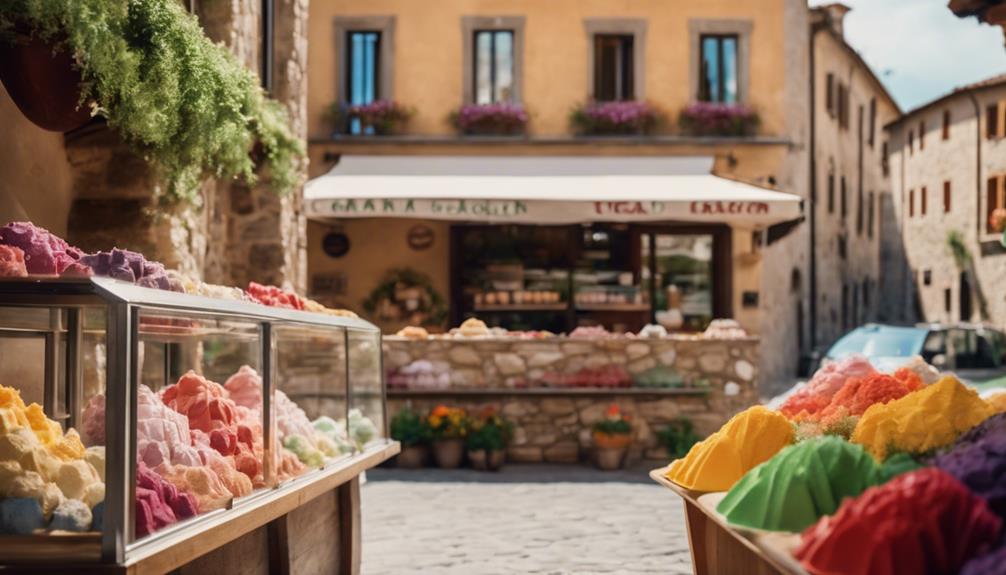To discover the top gelato spots in Tuscany, be sure to visit renowned establishments like Gelateria Dondoli in San Gimignano, famous for its unique flavors. Make sure not to overlook Gelateria di Castellina in Chianti, where seasonal ingredients take center stage. If you’re in the mood for something nutty, make your way to I Pini in San Casciano for their renowned pistachio gelato. BuonGusto in Pienza offers inventive flavors such as carrot-ginger, while Gelateria Veneta in Lucca offers classic choices in a charming outdoor setting. Follow your taste buds and explore, as each gelateria showcases Tuscany’s rich culinary traditions and seasonal ingredients. Your gelato journey is just beginning!
Key Takeaways
- Gelateria Dondoli in San Gimignano is renowned for unique flavors and multiple Gelato World Championships wins.
- Gelateria di Castellina emphasizes seasonal local ingredients for fresh and flavorful gelato experiences.
- I Pini in San Casciano is famous for its authentic pistachio gelato, loved by locals and tourists alike.
- BuonGusto in Pienza features innovative flavors like creamy basil and carrot-ginger, highlighting local sourcing.
Top Gelato Spots in Tuscany

When you're in Tuscany, you've got to check out the top gelato spots that showcase the region's amazing flavors and craftsmanship.
If you want the best gelato in Tuscany, you can't miss Gelateria Dondoli in San Gimignano. This award-winning gelateria has dazzled taste buds with unique combinations like tomato/strawberry/basil, earning multiple Gelato World Championships.
For a taste of seasonal local ingredients, head to Gelateria di Castellina in Castellina in Chianti. Their commitment to freshness means you'll enjoy gelato that truly reflects the flavors of the region.
If classic flavors are what you crave, I Pini in San Casciano in Val di Pesa is famous for its pistachio gelato, a favorite among locals and tourists alike.
Don't forget to visit Gelateria Veneta in Lucca, where you can enjoy classic flavors while relaxing in their outdoor seating.
Unique Flavor Experiences

Get ready to explore gelato like never before!
You'll discover innovative flavor combinations that highlight seasonal ingredients and showcase the importance of local sourcing.
Each scoop tells a story of Tuscany's rich culinary heritage, inviting you to experience something truly unique.
Innovative Flavor Combinations
Tuscany's gelaterias redefine dessert with their bold and unexpected flavor combinations, inviting you to explore a world of unique taste experiences.
Take a trip to Gelateria Dondoli in San Gimignano, renowned for its innovative flavor combinations like tomato, strawberry, and basil. This gelateria showcases the creativity of artisanal gelato makers, making every scoop an adventure.
If you're in Pienza, don't miss Nicola Sgarbi's shop, BuonGusto, where you can try creamy basil and carrot-ginger flavors, both highlighting locally sourced ingredients. Meanwhile, in Montepulciano, Dolcivoglie offers a similarly exciting array of flavors.
For a revitalizing twist, Gelateria Buon Gusto's ACE flavor, a blend of orange, carrot, and lemon, emphasizes seasonal produce and health benefits. Florence's Badiani gelateria features in-season specialties like kiwi, banana, and spinach, illustrating their commitment to fresh, local ingredients.
Many gelaterie, including Sgarbi and I Pini, focus on crafting limited flavors that rotate with local harvests, ensuring each visit offers a new and delightful tasting experience.
Seasonal Ingredient Highlights
Local gelaterias take pride in showcasing seasonal ingredients, allowing you to savor unique flavors that change with each harvest. This commitment to using seasonal local ingredients results in a dynamic gelato experience, where every visit offers something new.
You'll find that artisans creatively blend flavors, often using locally sourced fruits from nearby orchards, ensuring freshness and authenticity in every scoop.
Here are some innovative flavors you might encounter:
- Creamy Basil: A revitalizing twist that highlights the herb's aromatic qualities.
- Carrot-Ginger: A sweet and spicy combination that surprises the palate.
- Tomato-Strawberry-Basil: A standout flavor at Gelateria Dondoli, showcasing the region's produce.
These unique flavor experiences not only reflect Tuscany's rich agricultural heritage but also encourage you to return frequently, enthusiastic to discover the latest seasonal offerings.
With each scoop, you're not just tasting gelato; you're indulging in a culinary journey through the heart of Tuscany.
Local Sourcing Importance
Sourcing ingredients from nearby farms not only enhances the authenticity of gelato but also creates unique flavor experiences that change with the seasons. In Tuscany, many gelaterias prioritize local sourcing, which means you get to enjoy high-quality ingredients like saffron from San Gimignano or fresh fruits from local orchards. This commitment not only supports local farmers but also guarantees that each scoop reflects the rich terroir of the region.
You'll find that seasonal flavors are a hallmark of artisanal gelato in Tuscany. Gelaterias regularly update their menus based on the harvest, allowing you to experience the freshest tastes throughout the year. Imagine savoring a gelato made with freshly picked strawberries in the spring or indulging in a creamy pumpkin flavor in the fall.
Artisanal gelato makers, like Nicola Sgarbi, emphasize the importance of using fresh milk from local dairies delivered multiple times a week. This dedication to high-quality, locally sourced ingredients leads to creative combinations, such as carrot-ginger or kiwi-spinach, that you won't find anywhere else.
Identifying Quality Gelato

To identify quality gelato, look for labels like 'gelatoartigianale' that indicate it's hand-crafted and made with simple, natural ingredients. Here are some tips to help you spot the best gelato:
Check the color. Avoid overly bright colors; natural flavors should reflect the actual ingredients used.
Inspect the ingredients. Quality gelato typically contains milk, sugar, and natural flavors, steering clear of artificial additives.
Look for real pistachio gelato. High-quality versions use genuine nuts rather than artificial flavoring, which enhances the taste.
Observe the storage. Gelato should be stored in stainless steel containers and not stacked high to maintain its quality and texture.
Tuscan Gelato Culture

In Tuscany, gelato isn't just a treat; it's part of daily life.
You'll often find locals enjoying it in the afternoons and evenings, transforming a simple dessert into a social event.
As you stroll through town squares, you'll see people gathering to savor their favorite flavors while soaking in the vibrant atmosphere.
Frequent Gelato Consumption
Gelato isn't just a dessert in Tuscany; it's a cherished part of daily life, with locals indulging in it multiple times a week. Whether you're wandering through the charming streets of San Gimignano or relaxing in a piazza, you'll find that gelato is a staple, satisfying cravings and enhancing experiences.
Here are some reasons why gelato consumption is so frequent in Tuscany:
- Artisanal Tradition: Many gelaterias pride themselves on using traditional methods and locally sourced ingredients.
- Seasonal Flavors: Excellent gelaterias often rotate their offerings based on seasonal ingredients, keeping the selection fresh and exciting.
- Community Hub: Gelato shops serve as social gathering spots where friends and families come together.
The culture of gelato in Tuscany isn't just about enjoying a sweet treat; it's about savoring the moment, connecting with the community, and appreciating the artistry involved.
Socializing Over Gelato
Enjoying gelato in Tuscany goes beyond just savoring flavors; it's an opportunity to connect with friends and family in the heart of vibrant town squares. Gelato shops play a pivotal role in the Tuscan lifestyle, serving as popular meeting spots where social experiences thrive.
You'll find locals gathered, sharing laughs and stories over their favorite gelato flavors, fostering a sense of community interaction that's hard to replicate.
As you stroll through town, take a moment to indulge in people-watching while enjoying your treat. This leisurely activity not only enhances your experience but also deepens your connection to the local culture. The gelato you savor is crafted with quality ingredients, often passed down through generations, reflecting the region's rich culinary heritage.
In Tuscany, gelato isn't merely dessert; it's a way to bond with others, making every scoop a celebration of connection and tradition. So, grab a cone, find a cozy spot in the square, and immerse yourself in the vibrant social fabric of Tuscan life.
You'll quickly realize that every gelato moment is a chance to build memories and friendships that last.
Planning Your Gelato Tour

Planning your gelato tour in Tuscany means mapping out stops at renowned spots like Gelateria Dondoli and Gelateria di Castellina to indulge in award-winning flavors. To guarantee you find gelato that's truly the best, consider these tips:
- Time Your Visit: Plan your tour around local harvest seasons, when gelaterie showcase seasonal flavors made with fresh ingredients.
- Explore Hidden Gems: Seek recommendations from locals to uncover excellent gelaterie that mightn't be on the tourist radar.
- Make It Interactive: Consider joining gelato-making classes in places like Sgarbi in Montepulciano to deepen your appreciation of this culinary art while enjoying delightful samples.
Nicola Sgarbi's Gelato Journey

Nicola Sgarbi's passion for gelato began with crafting jam from foraged fruits, leading him to create artisanal gelato that captures the essence of Tuscany's fresh, local ingredients. Operating two gelato branches, BuonGusto in Pienza and Dolcivoglie in Montepulciano, he focuses on making gelato from scratch each morning. This dedication guarantees that every scoop reflects his commitment to quality.
Sgarbi emphasizes retraining customers to appreciate fresh, limited flavors made from high-quality, locally sourced ingredients. He sources fresh milk thrice weekly from a local dairy and uses premium pistachios from Sicily and hazelnuts from Piedmont. This attention to detail allows him to craft gelato that not only tastes amazing but also highlights the region's agricultural bounty.
His innovative flavors, such as creamy basil, carrot-ginger, and kiwi-spinach, showcase the unique combinations that set his creations apart. You're not just enjoying dessert; you're experiencing a culinary journey through Tuscany. When you visit one of Sgarbi's gelato shops, you'll appreciate how he transforms simple, local ingredients into extraordinary artisanal gelato that captures the spirit of the region.
Popular Gelato Flavors

You'll often find that popular gelato flavors in Tuscany highlight the region's rich culinary traditions and local ingredients. Tuscan gelaterie take pride in creating authentic flavors that reflect the area's bounty.
Here are some must-try gelato flavors:
- Pistachio gelato: This classic favorite boasts a rich, nutty flavor, often crafted with high-quality roasted pistachios from Sicily.
- Hazelnut gelato: Made with locally sourced hazelnuts, it showcases creamy and aromatic qualities that you won't want to miss.
- Stracciatella: A divine blend of creamy vanilla base and dark chocolate shavings, this flavor offers a delightful textural contrast.
When you explore gelaterie in Tuscany, these flavors will likely be on display, inviting you to indulge in their deliciousness. Each scoop you try not only satisfies your sweet tooth but also connects you to the region's culinary heritage.
Gelato Festivals and Events

In Tuscany, gelato isn't just a sweet treat; it's celebrated through vibrant festivals and events that showcase the artistry and passion of local gelatieri. The annual Gelato Festival is a highlight, where you can taste innovative flavors created by local artisans. This event not only features competitions for the best flavors but also interactive workshops that invite you to dive deeper into the world of artisanal gelato.
You'll experience the unique use of sustainable local ingredients, which makes each scoop a true reflection of Tuscany. During the festival, you'll have the chance to attend educational sessions focusing on gelato-making techniques, giving you insight into the craft from expert gelatieri.
These gelato festivals attract both locals and tourists, creating a lively atmosphere filled with laughter and deliciousness. Throughout the year, regional gelato events and workshops take place, further emphasizing the importance of gelato in Tuscan culinary traditions.
Frequently Asked Questions
Where Is the Best Place to Get Gelato in Italy?
When you're searching for the best gelato in Italy, explore local favorites. Try unique flavors at Gelateria Dondoli or classic options at I Pini. Each spot offers a delicious taste of Italian craftsmanship you won't forget.
How Do You Pick Good Gelato in Italy?
When it comes to gelato, you want to hit the nail on the head. Look for 'gelato artigianale', opt for natural ingredients, avoid bright colors, and sample flavors to find your perfect scoop.
Where Is the Best Gelato Place in the World?
When you're searching for the best gelato place in the world, look for shops with awards, unique flavors, and a commitment to quality. Trust local recommendations, and don't hesitate to try something new!
What Is the Number One Gelato in the World?
The number one gelato in the world is often considered to be from Gelateria Dondoli in San Gimignano. You'll love their innovative flavors, crafted with high-quality ingredients that create an unforgettable gelato experience.
Conclusion
So, as you commence your gelato adventure through Tuscany, remember to savor each scoop like it's a hidden treasure waiting to be discovered.
Whether you're exploring top spots or indulging in unique flavors, you'll find that each bite tells a story of tradition and passion.
Immerse yourself in the local gelato culture, and don't forget to join the festivals that celebrate this delightful treat.
Your taste buds are in for an unforgettable journey!









